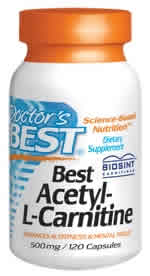|
Search Term: " Verigo "
How To Balance Crystals In Your Ear
Date:
May 16, 2017 11:44 AM
Calcium crystals in your ear can travel between the inner ear and the semi-circular canals, causing fluid imbalance and vertigo, a sudden dizzy sensation. If you get suddenly dizzy from abrupt head position changes or wake up dizzy, you probably have them. You should see your doctor who will try to reproduce the vertigo in their office. If crystals are the cause, there are some non-invasive maneuvers that can safely be fine at home to balance the crystals in your ear, preventing vertigo. Key Takeaways:
"When crystals accumulate in one of the ear canals they interfere with the normal fluid movement that these canals use to sense head motion" Read more: http://www.thealternativedaily.com/how-to-balance-crystals-in-your-ear/
(https://vitanetonline.com:443/forums/Index.cfm?CFApp=1&Message_ID=4629) Spinning out of control: Vertigo
Date:
January 18, 2017 10:59 AM
Vertigo can occur many situations. One of the most common manifestations of vertigo occurs when someone travels on a boat. While on a boat, particularly when not standing on the deck, your visual system indicates that there is not much movement, and your surroundings appear still. ear, on the other hand, is telling your brain that there is back and forth rocking movement, which naturally occurs with sea travel. The result is that one part of the brain is registering movement while the other part of the brain is registering no movement. Key Takeaways:
"To understand vertigo, one must understand that our sense of balance comes from multiple different systems in the body." Reference: //www.health.harvard.edu/blog/spinning-out-of-control-vertigo-2016122710919
(https://vitanetonline.com:443/forums/Index.cfm?CFApp=1&Message_ID=3797) Ferrum Phosphoricum and Your Health
Date:
June 26, 2014 10:59 PM
 What is a Ferrum Phosphoricum? What is a Ferrum Phosphoricum?Ferrum Phosphoricum or iron phosphate is a tissue salt used in Homeopathic medicine. It is derived from the combination of iron sulfate and phosphate. It also features prominently among the 12 Schuessler's Tissue Salts of Dr. Wilhelm Heinrich Schuessler. It is made by mixing iron sulfate, sodium phosphate, and sodium acetate. Then, this combination is ground to a fine powder and the resulting product is Ferrum Phosphoricum, which no longer retains any traces of the original compounds. Iron Iron is well known as being an important mineral for growth in humans and animals since it is responsible for blood formation, e.g., hemoglobin, and for oxygenizing tissues. Phosphorus Phosphorus serves its purpose by aiding in the development of bones and teeth and is considered to be a building block for certain B vitamins. Ferrum Phosphoricum Ferrum Phosphoricum is most often used where there is a need to fortify the blood, particularly the cell walls which transport blood. It is most commonly indicated at the beginning of an influenza or if there are feverish symptoms, after a period of prolonged bleeding, or for general malaise (weakness) where it excels greatly. People suffering from anemia and/or issues connected with deficient blood are said to benefit immensely by taking Ferrum Phosphoricum. Other indications for the use of Ferrum Phosphoricum are the following: • Tonsillitis • Fever • Vertigo • Sore throat • Rheumatism • Skin aliments Generally speaking Ferrum Phosphoricum is beneficial for those individuals who have weekend or delicate immune systems, or who catch colds easily. It is most useful when given during the first stages of illnesses, particularly where there is heat, fever, or inflammation. Part of the benefit of tissue salts and homeopathic remedies such as Ferrum Phosphoricum is that they are small, easily diluted and taste free. This makes them excellent for children and older individuals. Given the fact that they are quite inexpensive makes for all the more reason to give them a try. Sources
(https://vitanetonline.com:443/forums/Index.cfm?CFApp=1&Message_ID=3140) Can Lime Oil Benefit Ones Health?
Date:
February 20, 2014 05:04 PM
What is lime
Here are some of the health benefits of lime oil:
(https://vitanetonline.com:443/forums/Index.cfm?CFApp=1&Message_ID=3028) Is Sulfite Sensitivity And Vertigo Linked?
Date:
October 17, 2011 03:40 PM
Sulfites are chemical compounds which occur naturally in several animal and plant products. These chemicals are sulfur - based which is commonly used as food enhancer or preservative. Sulfites can effectively prolong the shelf life of food and also prevent discoloration of food. Foods which may contain sulfite include baked products, canned goods, junk foods, vegetable juices, fruit juices, apple cider, some teas and other processed food items. Sulfite - containing ingredients may include sulfur dioxide, potassium bisulfite or potassium metabisulfite and sodium bisulfite, sodium metabisulfite, or sodium sulfite. Allergic reaction to sulfite is not that rare. In fact, the Food and Drug Authority have established "1 out of 100 people" prevalence rate that is hypersensitive to sulfite and its products. Any person may develop allergic reaction to sulfites any time of his/her life. Studies revealed that the cause of such hypersensitivity is still unknown. More studies are still ongoing. Initial results have stated that the allergic effects can be mild or life – threatening. In late 1980's, the FDA released a memorandum on prohibiting the use of sulfite on fruits and vegetables that are commonly eaten fresh and raw such as lettuce, apples, guavas and the like. Regulations are also released for manufacturers to put labels on sulfite – containing processed food items. Sulfites also occur naturally among wines and beers. One theory revealed that sulfite allergic reaction may be caused by a significant insufficient amount of the enzyme necessary for the breakdown and elimination of such compound known as sulfite oxidase. This enzyme works hand in hand with the element molybdenum which acts as a cofactor. Nonetheless, asthma, nasal and sinus congestion, rhinitis, postnasal drip, headache and bronchospasm may also be experienced by the individual as an effect of sulfite consumption. In addition, vertigo may also be a manifestation of sulfite hypersensitivity. Studies have found that the allergic reaction brought about by the compound sulfite can significantly lower blood pressure thus resulting to decreased cardiac output which can eventually lead to insufficient tissue perfusion. Thus, dizziness is experienced or even loss of consciousness. Vertigo or dizziness is a kind of feeling in which your surroundings seem to be moving around even though there is no actual movement. In cases of severe vertigo, the person may experience nausea and vomiting. This will greatly affect your daily functioning since the person with vertigo may have difficulty walking or even standing on his/her own. This will significantly result to loss of balance and increase the risk of fall. There is no direct treatment of sulfite sensitivity. However, the symptoms can be alleviated in a palliative manner. The one and only way to prevent the occurrence of allergic reaction is to avoid food products with sulfites or food items which are likely to have sulfite content. Therefore, if you have sulfite allergy, you must be vigilant on what you eat. Carefully check labels of processed and preserved foods and when eating out, politely as the waiter or chef if the food you like contains sulfite or ingredients which contain such chemical compound. Foods to avoid: Alcoholic beverages, Baked goods (pastries), Beverages fruit based, Condiments, Relishes, Confections, Frostings, Modified Dairy Products, Drugs, Fish, shell fish, fresh fruit and vegetables, gelatin, puddings, grains, jams, jellies, nuts, plant proteins, snack foods, soups and soup mixes, sweet sauce, and instant teas. To name a few. Look online to view a more details list of foods to avoid. This practically eliminates most of our favored junk foods we love to eat. Avoiding these foods may be hard but it is a healthier choice.
(https://vitanetonline.com:443/forums/Index.cfm?CFApp=1&Message_ID=2511) Pennyroyal Herb
Date:
October 29, 2009 12:56 PM
Pennyroyal was brought by European settlers to the New World. There, they found that Native Americans were using the American variety of pennyroyal for repelling insects, skin irritations, and many of the same illnesses that they were using their own variety for. Additionally, this herb was used to soothe the stomach and relieve cold symptoms. The pennyroyal that is found in America has similar properties to the herb that is found in Europe. However, the European variety is thought to be much more potent. This herb possesses a volatile oil that works to remove gas from the stomach. It can be consumed as a tea of used as a footbath. If it is taken a few days before menstruation is due, it can help increase a suppressed flow. The pennyroyal tea is beneficial in relieving cold symptoms and also promoting perspiration. This herb has a strong, minty odor. It is used externally to repel insects like fleas, flies, and mosquitoes.
The oil of the pennyroyal plant is extremely concentrated and is often linked to toxic results. The oil is often associated with abortions and convulsions that result in death. It is believed that the oil irritates the uterus, which causes uterine contractions. The action is not predictable and is potentially dangerous. It is recommended that the oil be used only externally as a natural insect repellant. This herb is suggested for use as a decongestant for coughs and colds. Tea that is made from the pennyroyal herb is not associated with toxicity. In short, the entire pennyroyal plant is used to provide alterative, antispasmodic, antivenomous, aromatic, carminative, decongestant, diaphoretic, diuretic, emmenagogue, nervine, oxytocic, parasiticide, sedative, stimulant, and stomachic properties. Primarily, pennyroyal is extremely beneficial in treating bronchitis, childbirth pain, colds, colic, uterine cramps, fevers, gas, lung infections, and absent menstruation. Additionally, this herb is very helpful in dealing with convulsions, coughs, abdominal cramps, delirium, earache, flu, gout, headaches, leprosy, measles, migraines, mucus, nausea, phlegm, pleurisy, pneumonia, smallpox, sunstroke, toothaches, tuberculosis, ulcers, uterine problems, and vertigo. In order to obtain the best results when supplementing with this, or any herb, it is important to consult your health care provider before beginning any regimen. For more information on the many beneficial effects provided by pennyroyal, please feel free to consult a representative from your local health food store with questions.
(https://vitanetonline.com:443/forums/Index.cfm?CFApp=1&Message_ID=2108) Feverfew Herb
Date:
October 20, 2009 12:02 PM
Feverfew has been used for a long time as a natural remedy for pain relief, as it is considered an excellent remedy for migraines. This herb was used to treat any kind of pain and helped with chills and fever. Additionally, it helps in relieving colds, dizziness, tinnitus, and inflammation from arthritis. The herb works gradually and with a gentle action that allows the body to heal itself. The most popular use of feverfew is in the prevention and relief of migraine headaches. In a study, those given the placebo had an increase in frequency and severity of headaches, nausea, and vomiting. On the other hand, those given the feverfew capsules had no increase in frequency or severity of migraines. A randomized, double-blind, placebo-controlled, crossover study was done on seventy-two volunteers. One group received capsule dried feverfew leaves, while the other received a placebo. The group taking feverfew showed less severity of attacks and a reduction in symptoms that were associated with migraines, including vomiting. There was a definite improvement in the group using feverfew and no serious side effects resulted. Because some forms of migraines are believed to be associated with abnormal platelet behavior, feverfew may be beneficial as it has been found to help restrain the release of serotonin from platelets. This prevents a migraine from occurring.
It is thought that feverfew may also be a useful treatment in cases of rheumatoid arthritis. This is because of its ability to inhibit the formation of inflammation-promoting compounds like prostaglandins and leukotriene. The leaves and flowers of the feverfew plant are used to provide alterative, analgesic, anti-inflammatory, antimicrobial, aromatic, bitter, carminative, emmenagogue, febrifuge, nervine, parasiticide, mild purgative, stimulant, and vasodilator properties. The primary nutrients found in this herb are iron, niacin, manganese, phosphorus, potassium, selenium, silicon, sodium, vitamins A and C, and zinc. Primarily, feverfew is extremely helpful in dealing with chills, colds, fever, headaches, sinus headaches, and inflammation. Additionally, this herb is very beneficial in treating aches, ague, allergies, anxiety, arthritis, insect bites, poor circulation, dizziness, gastric disorders, nervous headaches, hot flashes, indigestion, and menopausal symptoms, absent menstruation, nervousness, tinnitus, and vertigo. For more information on the many beneficial effects provided by feverfew, please contact a representative from your local health food store.
(https://vitanetonline.com:443/forums/Index.cfm?CFApp=1&Message_ID=2104) Ginkgo Biloba
Date:
October 01, 2009 11:57 AM
The ability of ginkgo to boost brain function has been studied extensively. Most importantly, ginkgo increases oxygen supply to brain cells, as the brain is the body’s most sensitive organ to oxygen deprivation. Additionally, ginkgo has been used to improve electrical transmission in nerves and supply more oxygen and nutrients to brain cells. The effect that ginkgo has on the brain and circulatory system disorders seems to be extremely promising for a variety of conditions. Ginkgo extract has also helped dementia that results from poor blood flow to the brain. Senile dementia is often recognized by depression, unusual fatigue, and memory problems. Ginkgo has the ability to help improve circulation to the brain tissue, which in turn improves brain function. Blood platelet aggregation, or clotting, can cause serious problems in the body. Among these are strokes, heart attacks, and coronary thrombosis. It has been found that ginkgo can reduce the tendency for platelets to stick together and prevent them from forming clots in the arteries and veins.
The brain and nervous system are extremely sensitive to free-radical damage because of the high percentage of unsaturated fatty acids. It has been found that ginkgo’s antioxidant activity is particularly powerful in these areas, along with the eye and retina. The leaves of the ginkgo plant are used to provide adaptogen, alterative, antioxidant, antiseptic, and stimulant properties. Primarily, ginkgo is extremely helpful in treating ADHD, Alzheimer’s disease, lack of attention span, blood clots, cardiovascular disorders, poor circulation, dementia, dizziness, edema, impotence, inflammation, ischemia, memory loss, lack of mental clarity, multiple sclerosis, muscular degeneration, PMS, Raynaud’s disease, senility, stress, stroke, and tinnitus. Additionally, this herb is very helpful in dealing with allergies, angina, anxiety, arthritis, asthma, cancer, carpal tunnel syndrome, coughs, depression, lack of equilibrium, eye problems, hearing problems, hemorrhoids, lung disorders, migraines, mood swings, toxic shock syndrome, transplant rejection, varicose veins, vascular problems, and vertigo.
(https://vitanetonline.com:443/forums/Index.cfm?CFApp=1&Message_ID=2096) Motion Sickness
Date:
February 26, 2009 12:43 PM
Motion sickness is the result of motion causing the eyes, the sensory nerves, and the vestibular apparatus of the ear to send conflicting signals to the brain, causing a loss of equilibrium or a sense of vertigo. Most often, it is experienced in a car, airplane, train, boat, elevator, or swing. Contributing factors to this illness are anxiety, genetics, overeating, poor ventilation, and traveling immediately after eating. A susceptibility to things like offensive odors, sights, or sounds can often precede an attack of motion sickness. Typically, women are affected by this condition more frequently than men are. Elderly people and children under the age of two are usually not affected. Those people who suffer from motion sickness experience symptoms including severe headaches, queasiness, nausea, and vomiting while flying, sailing, or traveling in automobiles or trains. Other symptoms of motion sickness include cold sweats, dizziness, excessive salivation and/or yawning, fatigue, loss of appetite, pallor, severe distress, sleepiness, weakness, and occasionally, breathing difficulties that make one feel as if they are suffocating. If motion sickness is severe, an attack can make a person feel completely uncoordinated, and sometimes and injury can occur from loss of balance. The motion sickness typically goes away once the stimulus is removed. However, it can also persist for hours or days. If a person suffers from motion sickness for a prolonged amount of time, they may experience depression, dehydration, or low blood pressure. Motion sickness can also worsen any other illnesses that a person already has. Many natural remedies have been greatly successful in treating motion sickness. The prevention of motion sickness is the key, as it is far easier to prevent than it is to cure. Once excessive salivation and nausea set in, usually it is too late to do anything but wait for the trip to be over so that recovery can begin. The following nutrients have been recommended to help prevent motion sickness. Unless otherwise specified, the dosages given are for adults. For children between the ages of twelve and seventeen, the dose should be reduced to three-quarters of the recommended amount. For children between six and twelve, one-half of the recommended dose should be used, while one-quarter of the amount should be used for children under the age of six. Charcoal tablets can be used as a detoxifier. Five tablets should be taken one hour before travel. Magnesium, which acts as a nerve tonic, should be taken in dosages of 500 mg one hour before a trip. To help relieve nausea, 100 mg of vitamin B6 should be taken one hour before a trip, and then 100 mg should be taken again two hours later. Additionally, black horehound can help to reduce nausea. Butcher’s broom, kudzu, and motherwort are great for helping to relieve vertigo. Ginger is beneficial in suppressing nausea, making it an excellent treatment and preventive for nausea and upset stomach.
Lastly, peppermint tea sooths and calms the stomach. Also, a drop of peppermint oil on the tongue is a great way to provide relief from nausea and motion sickness. Peppermint can also be taken in a lozenge form. To learn more information about the above nutrients, contact your local or internet health food store.
(https://vitanetonline.com:443/forums/Index.cfm?CFApp=1&Message_ID=1971) Ginkgo Biloba Extract
Date:
September 19, 2008 09:25 AM
Ginkgo biloba, also known as the maidenhair tree, grows naturally in two small areas of Eastern China. It is believed that even these sources are artificial, and planted and maintained by monks over many centuries, and that there are no true natural sources of the tree left. Other than these, all living ginkgo trees are now artificially farmed. The ginkgo seeds contain nuts that are a traditional food in China, served at Chinese New Year, and on other special occasions such as weddings, and is also used in traditional Chinese medicine. The seeds have been used in the treatment of coughs and asthma, and during the late 1970s and 80s, the uses of ginkgo biloba in medicine was extensively investigated with a view to determine the range of conditions that the tree could be used to treat. Given that many ancient Chinese remedies have found to be effective, and with a relevant scientific basis, this was a logical step. It has been established that ginkgo biloba could have three possible effects on the body. These are:
* Improvement in circulation including that in the small capillaries. The last of these has been responsible for many cardiovascular conditions, and disorders of the kidneys, lungs and central nervous system, and is due to the effect of the platelet-activating factor (PAF) that ginkgo appears to inhibit. Before delving deeper into the possible beneficial effects of Ginkgo, let us first examine the active ingredients believed to be involved in the perceived beneficial effects. Ginkgo leaf extract contains terpenoids (bilobalides and ginkgolides) and flavonoid glycosides. Flavones can reduce the fragility of capillaries, and protect the body from blood loss through damaged capillaries, particularly in the brain. The Ginkgolides, particularly ginkgolide B, inhibit the platelet-activating factor and so increase the fluidity of the blood that improves circulation, again particularly in the micro-capillaries of the brain. This is also why it is believed to reduce the incidence of cerebral thrombosis and resultant strokes. The antioxidant effect of ginkgo biloba extract (GBE) has been widely studied, and by scavenging free radicals the extract can help to prevent cell membrane damage, and so prevent cells from being destroyed. It has been established that pretreatment of cells with GBE can prevent such damage in rats. The anti-inflammatory properties of ginkgo biloba, as seen in some asthma patients for example, is thought to be due to the inhibition of the platelet-activating factor (PAF) by ginkgolide B, PAF playing a significant part in the inflammatory response to allergens, and PAF is now believed to be responsible for conditions such as asthma, renal diseases, central nervous system disorders and ischemia, a restriction in the blood supply, particularly to the brain. It follows, therefore, that the effect of GBE on these conditions is likely to be due to PAF inhibition, and a reduction in the inflammatory response to a number of conditions. What evidence is there for this? In fact, results of the trials carried out have been inconclusive one way or the other. Hence, a trial published by the Journal of the American Medical Association reported no effects after a 6 week trial of Ginkgo on Alzheimer’s and memory disorders. However, other trials have indicated positive effects after 6 weeks, and it could be that the GBE has to be taken for more than 6 weeks for any effects to be noticed. It is certainly believed to be a longer term treatment rather than have instant results, although some tests have shown improvement in concentration for up to 2.5 hours after treatment. The bulk of the evidence is favorable on the effect of GBE on memory disorders. Test on rats, in which the blood flow to the brain was mechanically blocked by carotid compression, indicated that ginkgo biloba promoted an increase in the glucose and ATP levels in the brain neurons. Other trials have indicated that neurological damage in mice subjected to neurotoxins was reduced by the administration of GBE, and while not conclusive with respect to humans, the effect of GBE on the brain appears to be more than just opinion. To sum up, ginkgo biloba is believed to be effective in treating the following disorders by virtue of its effect in improving the fluidity of the blood, protecting fragile capillaries from damage, exerting an antioxidant effect on free radices, and so prevent damage to cell membranes, and its inhibiting effect on platelet-activating factor: Circulation Problems Circulation problems in the arteries can lead to blood clots that in turn cause strokes and cardiac problems. By preventing blood clots through the inhibition of PAF, ginkgolide B can help to maintain a healthy circulation system that also help to maintain circulation in the very small capillaries that feed the brain. Atherosclerosis This is caused by hardening and blockage of the arteries, and one of the effects of ginkgo biloba is to soften the arteries, help to unblock them and to prevent plaque formation by its antioxidant effect on the free radicals that cause the plaque by oxidation of LDL lipids. This is particularly true of the cerebral arteries. Memory Impairment The increased blood flow to the brain that GBE promotes can help to improve memory, although test are indicating that treatment has to continue for 6 weeks or more for it to be effective. Reduced blood flow to the brain is a common cause of memory impairment. Alzheimer’s disease Ginkgo biloba has been used in the treatment of the symptoms of this condition, although it cannot be cured. It is thought that the improved circulation in the brain makes best use of the unaffected brain cells, improving memory and cognitive thought. Reynard’s Disease This is a condition where the extremities fail to warm up after being exposed to cold, and is caused by poor circulation in the small capillaries in which the blood pressure is very low. They symptoms are numbness and pins and needles, and GBE helps to overcome this condition due to improvement in the circulation and protection of the capillaries by rendering them less fragile. Vertigo GBE can help to reduce the symptoms of vertigo such as nausea and dizziness. This is believed, once again, to be due to an improvement in blood circulation.
There are few doubts that ginkgo biloba extract improves the circulation, particularly in the micro-capillaries in the brain and extremities of the body, and also possesses antioxidant properties, both of which help to maintain and improve the memory, and that combined with its effect on the platelet-activating factor, most of the properties of GBE is due to its capacity to maintain and improve circulation, particularly through those blood vessels closest to the blood-brain barrier.
(https://vitanetonline.com:443/forums/Index.cfm?CFApp=1&Message_ID=1894) A Periwinkle Extract Vinpocetine May Promote Cerebral Blood Flow
Date:
December 01, 2007 09:05 AM
Periwinkles form the plant genus Vinca, of which the lesser periwinkle and the greater periwinkle are the two members. They are also a form of dogbane, known for its alkaloid properties. Periwinkles are of interest to the medical profession due to their biosynthesis of a number of alkaloids that are used to protect themselves from bacteria and are also toxic to the herbivores that would otherwise eat them. Many other plants produce alkaloids, perhaps the best known being poppy, that produces the alkaloid opium that is the precursor to heroin. The alkaloids of the periwinkle, however, have a much more beneficial use for mankind in their action on certain types of cancer such as Hodgkin’s disease, and also on the flow of blood to the brain.
The components of the periwinkle include vinblastine, which is used in the treatment of Hodgkin’s lymphoma, and it is the only plant known to produce the alkaloid, although only in very small quantities after synthetic seeding. This involves introducing modified tryptamines to the plant so that they produce the desired alkaloid, although only in quantities of 0.002% of the weight of the plant. Although small, this is still less expensive that synthesizing the alkaloid in a chemical plant rather than a biological one! Chemists are now seeking more readily synthesizable alternative forms of the alkaloid that have the same effect, again using the periwinkle as a botanical chemical factory to provide them with a lead as to possible synthetic routes. However, it is for the application of another alkaloid of this amazing little plant that we are more concerned with here. In addition to vinblastine, the periwinkle produces the alkaloid vincamine, a type of tryptamine that can be extracted from the leaves of the lesser periwinkle, the Vinca minor. This periwinkle has been used through the ages as an invigorating tonic and as an astringent to treat bleeding gums and sores in the mouth. Vincamine promotes the aerobic glycolysis that is essential to cerebral health. Normal glycolysis, or the conversion of glucose to energy in the mitochondria of the cells of the body, occurs best in the absence of oxygen (anaerobic glycolysis). However, the brain produces up to and over 90% more energy through aerobic glycolysis in the presence of oxygen than through anaerobic. Hence one of the needs for such a rich supply of oxygenated blood being needed by the brain. As people grow older, or their brain tissue becomes damaged, then the supply of blood can be reduced and more and more anaerobic glycolysis is switched on. This results in an increasing loss of brain energy and hence brain function. Vincamine can reverse this effect, or at least maintain the status quo, and so enable people to maintain their brain function for longer. It is also what is known as a vasodilator, and dilates the blood vessels in the brain allowing a greater blood flow. It is known to be beneficial in relation to tasks requiring focused concentration such as mathematical problem solving, and has also been found effective in the treatment of people with poor memory. Vinpocetine (ethyl apovincaminate) is a derivative of vincamine, obtained by slightly modifying the molecule to produce a commercial form of the alkaloid. This possesses all of the beneficial effects of its precursor, including its positive effects on memory, believed to be due to the stimulation of serotonin production that improves the rate at which the brain can process information. Tinnitus, or ringing in the ears that has severely reduced the quality of life of so many people, can also be treated with vinpotecine. Its vascodilation effect is thought to be through its action as a phosphodeaterase 1 (PDE1) inhibitor that results in an improvement in the plasticity of neurons. The mechanism is complex, but the end result is an improvement in the cognitive abilities of the subject. This is supplemented by the effect of vinpocetine on the calcium levels in the blood vessels. This renders them more plastic in much the same way that some anti-hypertension treatments work to reduce blood pressure by increasing the plasticity of the blood vessels by modification of their calcium levels. It can also reduce the viscosity of the blood through its action on the “stickiness” of leucocytes and so allow the blood to run more freely through the capillaries of the brain. These effects have been demonstrated through double blind studies, and there is little doubt that vinpocetine helps to maintain a healthy cerebral circulation. So let’s have a recap on its various effects, and then finish with a summary of the conditions that the alkaloid can be used to treat or improve. The theory and biochemistry behind these effects is known, but is complex, but here are the major actions: a) It improves blood flow by modifying the calcium content of the blood vessels and so improves their elasticity, hence allowing a freer movement of blood. In effect it helps the blood vessels to dilate easier. b) It inhibits the enzyme PDE1 and by doing so helps to restore the elasticity of neurons in aging brain cells, allowing them to relax more and operate more effectively. c) It promotes aerobic glycolysis, and so the rate at which the mitochondria of brain cells produce ATP (adenosine triphosphate) that is the chemical manifestation of energy. d) It helps to maintain a good supply of glucose and oxygen in the brain to allow (c) to occur. Not all of these may be separate effects, but the outcome is an improvement in conditions such as short term memory loss, dementia and other conditions associated with a reduction in the blood supply to the brain including Menière’s syndrome and vertigo. There is also evidence that it helps with hearing problems, macular degeneration of the eye, and fatigue. It is a supplement that should be taken by the elderly to help with age-related memory problems, but has also been found to be beneficial in normal healthy people. The periwinkle extract Vinpocetine has been shown to have benefits, largely through an increase in the blood flow to the brain, and will be of use to anybody suffering from conditions that can be related to a deficiency in their cerebral blood supply.
(https://vitanetonline.com:443/forums/Index.cfm?CFApp=1&Message_ID=1643) Benefits of Acetyl-L-Carnitine
Date:
February 12, 2006 01:55 PM
(https://vitanetonline.com:443/forums/Index.cfm?CFApp=1&Message_ID=1216) TRADITIONAL USES
Date:
June 25, 2005 01:08 PM
TRADITIONAL USES Folk tales and myths surround the ginseng plant in all its varieties. It was thought to be the ultimate herb for strength, vigor and a long life. The Asian ginseng used throughout China was thought of as the ultimate cure-all. It has been highly esteemed and used for thousands of years. Ginseng is stimulating on the entire body to help overcome stress, increase longevity, fatigue, weakness, mental fatigue, improve brain cell function, and benefit the heart and circulation. It is also used to normalize blood pressure, reduce cholesterol levels, and to prevent artherioslcerosis. It is used to help protect the body against radiation and as an antidote to drugs and toxic chemicals. Ginseng is often given alone or in combination with other herbs to restore balance in the body. Folk medicine recommends ginseng for many ailments such as amnesia, cancer, atherosclerosis, asthma, diabetes, coughs, heart, fear, fever, epilepsy, hypertension, malaria, impotence, insomnia, longevity, swelling, sores and vertigo. It is probably safe to say that ginseng is one of the most popular and most prescribed natural remedies for just about anything. Ginseng has been used to rejuvenate the body and maintain health. It is used to promote regeneration at times of stress on the body. It also helps when the body has undergone illness or surgery. It is also thought to help increase longevity and keep the body looking young with less signs of aging. It is not only promoted for physical longevity but also for mental function. Ginseng is often used to help strengthen the male reproductive systems. It is thought to be especially healing on the prostate gland. It is also used as an aphrodisiac. Ginseng is also thought to produce some testosterone in women, and for this reason, is not recommended for long periods of time. Panax ginseng is thought to increase male hormone production.
(https://vitanetonline.com:443/forums/Index.cfm?CFApp=1&Message_ID=482) Summary of Specific Actions Associated with Ginkgo
Date:
June 25, 2005 12:39 PM
Summary of Specific Actions Associated with Ginkgo
Unquestionably, ginkgo will continue to enjoy its current popularity. As baby boomers continue to enlarge the senior citize n block of our population, supplements which have the ability to deter or even prevent age-related disorders will be vigorously sought after.
Ginkgo can be used in these combinations for bioenhancement: Ginkgo: Primary Applications The following are general areas that ginkgo biloba can be used effectively:
Secondary Applications The following are areas of secondary application for ginkgo biloba:
(https://vitanetonline.com:443/forums/Index.cfm?CFApp=1&Message_ID=465) Increased Brain Power and Memory with Ginkgo
Date:
June 25, 2005 11:23 AM
Increased Brain Power and Memory with Ginkgo Ginkgo’s ability to enhance cognitive function is becoming common knowledge. Boosting the capability of the brain to record information, communicate ideas or recall concepts can all be enhanced by taking ginkgo biloba therapeutically. Evidently, providing a better oxygen supply to brain cells is ginkgo’s primary neural action. The brain is the body’s most sensitive organ to oxygen deprivation. Today, more than ever, the effects of smoking, alcohol and stress in general can diminish brain function and compromise mental alertness. Ginkgo has demonstrated over and over that it can make a significant difference in memory retrieval, fact retention and problem solving. One of the most impressive aspects of ginkgo is its ability to stimulate circulation and oxygen flow to neural tissue, there by improving cognitive functions and memory. In test cases when ginkgo has been administered, an increase in cerebro-circulation has been noted in both healthy or diseased brain tissue. What makes this finding particularly relevant is that other circulatory enhancers, whether natural or synthetic do not usually possess this capability. In addition, ginkgo increases oxygen transport at the blood-brain barrier site, while inhibiting the permeability of toxins into brain tissue. As well as boosting blood supply to the brain, ginkgo has demonstrated the ability to increase the rate at which information is transmitted at the nerve cell level.2 In a double-blind study, one group of healthy young women received ginkgo extract, and the other was given a placebo. A memory test was administered and the reaction time in those women who had taken the ginkgo improved significantly. These findings corresponded with EEG tracings which showed increased brain wave activity.3 Short-term memory and basic learning rates can be statistically improved by using ginkgo. Ginkgo’s ability to enhance memory may also be helpful for epileptics who take anticonvulsants. Typically, an anticonvulsant can impair memory function, making it difficult to retrieve names or numbers from memory banks. In addition, although research is lacking, because ginkgo stimulates brain function, it may help to inhibit improper discharging of electrical impulses which is the primary cause of seizures in epileptics. Ginkgo is rapidly gaining an impressive reputation as a brain enhancer. It has demonstrated its capability to improve memory, mental efficiency and the ability to concentrate. It has also been shown to reduce anxiety, headaches, tension, vertigo, and age-related cerebral disorders. Anyone who has suffered a stroke should look into the possible benefits of ginkgo to amplify mental function and clarity. Considerable research on ginkgo conducted in Eu rope has confirmed that ginkgo does indeed facilitate better arterial circulation as well as improve electrical transmission in the nerves. The latter function also contributes to improved oxygenation and nutrition to the brain.4 Ginkgo is now accepted as a brain booster which improves memory, mental efficiency, cognitive function, communication, orientation and the ability to concentrate. Recently, the notion of using ginkgo for learning disorders has received some attention. Forthcoming research on the subject will help to clarify its potential for treating such conditions.
(https://vitanetonline.com:443/forums/Index.cfm?CFApp=1&Message_ID=449) Homeopathic Essentials
Date:
June 11, 2005 05:13 PM
Homeopathic Essentials by Jane Lane Energy Times, February 1, 2000 The principles of homeopathy are elegantly basic and, to some, maddeningly elusive. This system of medical treatment employs The Law of Similars or "like cures like," and calls on natural plant, animal and mineral substances that induce the body to heal itself. That homeopathy works is virtually incontrovertible. With its ancient roots and European practice spanning hundreds of years, homeopathy employs minute doses of diluted extracts to replicate symptoms of a malady, which then vanishes. But the very fact that it works puzzles many experts who have researched the phenomenon. Understanding The Tradition Homeopathy evolved from its earliest practice recorded by 10th-century BC Hindu sages to its codification by Hippocrates in 400 BC. " Through the like, disease is produced and through the application of the like, it is cured," he wrote, expressing the fundamental principle of homeopathy, according to Homeopathic Medicine at Home (Tarcher Perigee) by Maesimund B. Panos, MD, and Jane Heimlich. Samuel Christian Friedrich Hahnemann, the erudite and intellectually audacious German physician and chemist, seized upon the essentials of homeopathy in the early 1800s. Through Hahnemann's work, homeopathy developed into an intricately systematized science, veering into the arcane for the contemporary individual seeking relief for everyday ailments. Modern practitioners and manufacturers of homeopathic remedies benefit from Hahnemann's daring research (which included potentially lethal experiments on himself) and complex doctrines. They've streamlined and modernized Hahnemann's concepts to provide more relevance to modern ills and sensibilities. The Bold Experiments Hahnemann denounced the medical practices of the 18th century, which involved cauterizing, bleeding, blistering and purging patients to expel the pernicious fluids or humors believed to cause disease. He also reviled the kind of omnibus prescription drugs of the day, which loaded many substances into one compound. In 1790, Hahnemann conducted his groundbreaking experiment establishing the basis of homeopathy. The customary treatment for malaria at the time was Cinchona officinalis or Peruvian bark-quinine. Medical wisdom attributed its efficacy to its bitterness and astringency. Hahnemann rejected this explanation, noting that other botanicals are far more bitter and astringent, yet are powerless against malaria. To prove his theory, Hahnemann took some cinchona compound and promptly developed the symptoms of malaria. His deduction: Like cures like, or The Law of Similars. A substance that, in minute doses, induces certain symptoms in a healthy person cures a sick one. The Set of Laws A set of fairly complex laws developed from Hahnemann's initial Law of Similars. The Law of Proving refers to the process of ascertaining the effectiveness of a homeopathic therapy by administering a substance to a healthy person to record in minute detail its effects. Practitioners also use the standard double-blind method using a placebo or unmedicated tablet against a homeopathic compound. The first proving was performed in 1790 and the procedure endures today, using only humans, not laboratory animals, for greater accuracy. As homeopathic preparations are not toxic, proving has never produced lasting adverse reactions. Descriptions of provings are compiled into books called materia medicas, including Boericke's Materia Medica and Repertory and The Lectures of Homeopathic Materia by James Tyler Kent, used regularly in contemporary practice. The books are highly indexed collections of symptoms and the remedies that cure them called repertories. The most extensively used repertory is Kent's Repertory of the Homeopathic Materia Medica. In 1800, the third Law of Potentization was devised, regulating the processing of homeopathic remedies through successive dilutions and shaking. This law represents perhaps the profoundest mystery of homeopathy and demands the boldest leap of faith: The higher the dilution, the more intense the potency of the medicine. Substances that are inert in their natural state act as medicine. And as they are so dilute, homeopathic remedies do not act directly on the tissues, accounting for their non-toxicity. Adding to the inherent safety of homeopathic therapies is the discipline's adherence to the single remedy. Centuries ago, homeopaths seemed to have been prescient about current drug interaction troubles. (Historical information courtesy of Homeopathic Medicine at Home by Panos and Heimlich.) How It Works: The Vital Force Homeopathy embraces a philosophy centered on the concept of "vital force," an intelligent, dynamic life force within each individual responsible for maintaining one's life and balance on all levels. The vital force creates a defense mechanism similar to the immune system, but incorporates protection against imbalances on the emotional and mental planes as well. Homeopathy equates disease with imbalance. As the defense mechanism attempts to restore balance, symptoms appear: pain, swelling, rashes and fevers on the physical side; grief, jealousy, anxiety, anger, confusion and loss of memory on the emotional and mental end. Homeopaths regards these symptoms as evidence of the vital force's curative exertions, not merely annoyances to be eliminated. Symptoms guide the homeopath in his or her attempts to harmoniously augment the efforts of the vital force. Homeopathy Today Homeopathic remedies are prepared according to the standards of the United States Homeopathic Pharmacopoeia and are recognized by the US Food and Drug Administration. " Homeopathy respects the complexity and uniqueness of each individual," observes pharmacist and naturopathic doctor James LaValle (and his co-authors) in Smart Medicine for Healthier Living. "To identify the correct homeopathic remedy, you must carefully observe your unique-even quirky-behaviors and responses." Indeed the emphasis on the "unique, even quirky" may lead to the perception of homeopathy as a sketchy pseudo-science. Homeopathy simply does not fit the drug model of allopathic medicine. Its ability to help people, however, has been repeatedly evaluated through rigorous scientific research. A comprehensive review in the British Medical Journal (302, 1991: 316-323) of more than 100 clinical studies of homeopathy published during the last 30 years revealed that 77% of those studies produced positive results for the people involved. A host of additional studies provides clinical evidence:
(https://vitanetonline.com:443/forums/Index.cfm?CFApp=1&Message_ID=295) | ||||||||||||||||||||||||||||||||||||||||||||||||||||||||||||||||||||||||||||||



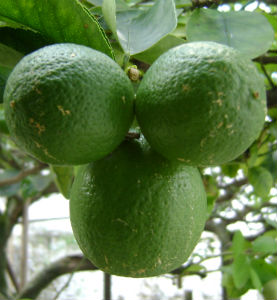 Lime, a green citrus fruit resembling lemons, is believed to have originated in Eastern Malaysia. While it is more popular as a citrusy, sweet, and oftentimes sour pulp and juice, lime oil can also be used to improve one's health.
Lime, a green citrus fruit resembling lemons, is believed to have originated in Eastern Malaysia. While it is more popular as a citrusy, sweet, and oftentimes sour pulp and juice, lime oil can also be used to improve one's health. 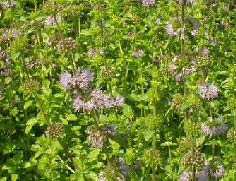 The pennyroyal herb is a member of the mint genus. It is an essential oil that is extracted and used in aromatherapy. Crushed pennyroyal leaves and foliage give off a very strong spearmint fragrance. Traditionally, pennyroyal is used as culinary herb, folk medicine, and abortifacient. This herb was commonly used by the Greeks and Romans as a cooking herb. The Greeks often flavored their wine with pennyroyal. Additionally, a large number of the recipes in the Roman cookbook of Apicius use pennyroyal along with herbs such as lovage, oregano, and coriander. Although it was still commonly used for cooking in the Middle Ages, it slowly fell out of use as a culinary herb. Today, it is seldom used. However, the essential oil of pennyroyal is extremely high in pulegone, which is toxic volatile organic compound, and is therefore poisonous to the liver and can stimulate uterine activity.
The pennyroyal herb is a member of the mint genus. It is an essential oil that is extracted and used in aromatherapy. Crushed pennyroyal leaves and foliage give off a very strong spearmint fragrance. Traditionally, pennyroyal is used as culinary herb, folk medicine, and abortifacient. This herb was commonly used by the Greeks and Romans as a cooking herb. The Greeks often flavored their wine with pennyroyal. Additionally, a large number of the recipes in the Roman cookbook of Apicius use pennyroyal along with herbs such as lovage, oregano, and coriander. Although it was still commonly used for cooking in the Middle Ages, it slowly fell out of use as a culinary herb. Today, it is seldom used. However, the essential oil of pennyroyal is extremely high in pulegone, which is toxic volatile organic compound, and is therefore poisonous to the liver and can stimulate uterine activity. 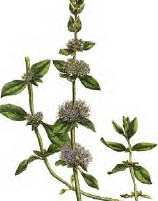 In fact, it helps to relax the digestive tract and soothe the stomach.
In fact, it helps to relax the digestive tract and soothe the stomach. 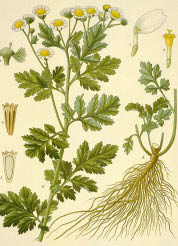 For thousands of years feverfew has been used for the treatment of various ailments. History is full of references to feverfew. Dioscorides, an ancient Greek herbalist, recommended the use of feverfew almost two thousand years ago, as he valued the herb for childbirth, fevers, melancholy, and congestion of the lungs. It was also suggested for arthritis. In 1772, feverfew was suggested to be used to treat painful headaches. Many people believe that feverfew obtained its name from its use as a remedy for bringing down fevers, but this has been determined to be incorrect. Instead, the name came from the traditional Old English name for feverfew, featherfew. Featherfew came from the feather-shaped leaves of the feverfew plant.
For thousands of years feverfew has been used for the treatment of various ailments. History is full of references to feverfew. Dioscorides, an ancient Greek herbalist, recommended the use of feverfew almost two thousand years ago, as he valued the herb for childbirth, fevers, melancholy, and congestion of the lungs. It was also suggested for arthritis. In 1772, feverfew was suggested to be used to treat painful headaches. Many people believe that feverfew obtained its name from its use as a remedy for bringing down fevers, but this has been determined to be incorrect. Instead, the name came from the traditional Old English name for feverfew, featherfew. Featherfew came from the feather-shaped leaves of the feverfew plant. 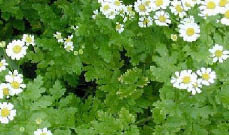 This herb seems to have similar properties to non-steroidal anti-inflammatory agents (NSAIDs), like aspirin. Feverfew may actually be even more effective with a lot fewer potential complications. Some of the studies involving feverfew and migraines have shown that feverfew may also lower blood pressure.
This herb seems to have similar properties to non-steroidal anti-inflammatory agents (NSAIDs), like aspirin. Feverfew may actually be even more effective with a lot fewer potential complications. Some of the studies involving feverfew and migraines have shown that feverfew may also lower blood pressure.  In the past decade, ginkgo has received much attention. It has been revered throughout China and other areas of Asia for thousands of years. However, its popularity increased in Western countries. An increase in sales can be attributed to interest in the benefits of ginkgo on conditions that are associated with aging like Alzheimer’s, memory loss, dementia, and circulatory disorders. Often, gingko is used to increase the blood flow to the brain, which improves memory problems like Alzheimer’s, to prevent strokes, and to increase blood circulation through vasodialation. The improved circulation is also thought to improve ear conditions, help blood flow to the retina, aid in preventing muscular degeneration, reduce frequency of asthma attacks, and help transplant recipients avoid rejection.
In the past decade, ginkgo has received much attention. It has been revered throughout China and other areas of Asia for thousands of years. However, its popularity increased in Western countries. An increase in sales can be attributed to interest in the benefits of ginkgo on conditions that are associated with aging like Alzheimer’s, memory loss, dementia, and circulatory disorders. Often, gingko is used to increase the blood flow to the brain, which improves memory problems like Alzheimer’s, to prevent strokes, and to increase blood circulation through vasodialation. The improved circulation is also thought to improve ear conditions, help blood flow to the retina, aid in preventing muscular degeneration, reduce frequency of asthma attacks, and help transplant recipients avoid rejection. 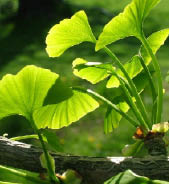 Ginkgo has also been found to be effective in treating migraine headaches. In one study that took place in 1975, ginkgo extract was given to individuals who were suffering from migraines. Results concluded that eighty percent of the patients showed improvement or were cured of the condition.
Ginkgo has also been found to be effective in treating migraine headaches. In one study that took place in 1975, ginkgo extract was given to individuals who were suffering from migraines. Results concluded that eighty percent of the patients showed improvement or were cured of the condition.  This is extremely helpful in conditions like retinopathy, cataracts and macular degeneration. The central nervous system possesses fat lipids in the cell membranes that are typically attracted by free radicals. Ginkgo can help protect these cell membranes and prevent condition which can occur in the brain and nervous system that are often associated with aging, like memory loss.
This is extremely helpful in conditions like retinopathy, cataracts and macular degeneration. The central nervous system possesses fat lipids in the cell membranes that are typically attracted by free radicals. Ginkgo can help protect these cell membranes and prevent condition which can occur in the brain and nervous system that are often associated with aging, like memory loss. 